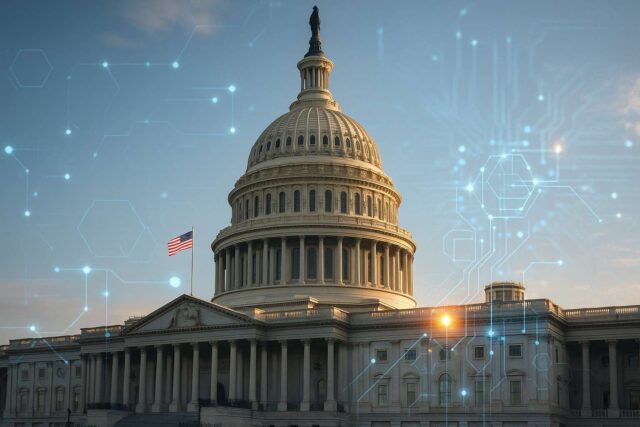In a landmark move signaling the maturation of blockchain policy in the United States, the U.S. House of Representatives has passed H.R. 1664, officially titled the Deploying American Blockchains Act of 2025. This U.S. blockchain bill 2025, introduced with strong bipartisan backing, directs the Secretary of Commerce to create a national blockchain strategy that will coordinate federal efforts, support private sector innovation, and help strengthen America’s global digital position.
The legislation is more than symbolic. It represents Washington’s clearest step yet toward institutionalizing blockchain as a strategic technology. Lawmakers now rank it alongside AI and quantum computing in terms of national importance.
What the Bill Actually Does
At its core, H.R. 1664 requires the Commerce Department to develop a comprehensive blockchain roadmap. This includes:
- Identifying federal use cases for blockchain applications.
- Collaborating across federal agencies to ensure technological coherence.
- Consulting with private sector stakeholders to align innovation with policy.
- Establishing guiding principles to encourage responsible blockchain development.
The roadmap aims to accelerate blockchain integration across government systems. It also seeks to reduce fragmentation in the domestic regulatory environment, long a challenge for crypto and Web3 projects.
The Global Tech Race: Why Now?
The Deploying American Blockchains Act comes amid growing concern that the United States is falling behind in the global blockchain innovation race. China’s state-backed Blockchain-based Service Network (BSN) and the EU’s regulatory progress with the Markets in Crypto-Assets (MiCA) framework have raised alarm bells in Washington.
Lawmakers from both parties emphasized that a lack of cohesive policy has discouraged Web3 entrepreneurs and investors from operating within the U.S. jurisdiction. Supporters of the bill argue that a national blockchain strategy is essential for setting global standards, fostering innovation, and ensuring the U.S. leads rather than lags in next-generation digital infrastructure.
>>> Read more: BITCOIN Act Approved, GENIUS Act Hits a Wall
Institutionalizing Blockchain Strategy
What makes this bill different from prior legislative attempts is its institutional clarity. Rather than issuing piecemeal guidance or punitive enforcement, the U.S. government is now committing to a federal blockchain framework that spans across sectors and stakeholders.
For enterprises, it means potential integration with government systems, procurement clarity, and long-term policy stability. For regulators, it provides a unified structure to guide oversight. And for developers and founders, it creates a more predictable environment to build and scale.
Market Implications and Web3 Outlook
While the bill does not directly regulate cryptocurrencies, many in the industry interpreted its passage as a positive signal for Web3 adoption. Analysts predict that clearer national policy could lead to:
- Increased capital inflow into U.S.-based blockchain startups.
- Strengthened public-private partnerships for decentralized infrastructure.
- A friendlier legal environment for token issuance and on-chain innovation.
Crypto markets responded with cautious optimism, with several leading platforms calling the bill “a pivotal moment” for the U.S. digital asset ecosystem.
What Happens Next?
The legislation now heads to the Senate, where it is expected to face further discussion but has already garnered bipartisan interest. If signed into law, the Deploying American Blockchains Act will require the Secretary of Commerce to deliver a finalized national blockchain strategy within one year.
In parallel, industry stakeholders are already preparing to engage with the Commerce Department to ensure their needs and innovations are reflected in the federal blockchain roadmap.
>>> Read more: GENIUS Act Clears Senate, Reshaping U.S. Stablecoin Regulation
With the passage of H.R. 1664, the United States is making a formal play to reclaim its leadership in emerging technologies. The Deploying American Blockchains Act of 2025 is more than a legislative accomplishment; it’s a strategic inflection point.
By mandating a coordinated, forward-looking blockchain policy, Washington’s message is clear: the future of digital infrastructure will not be left to chance, and the U.S. intends to lead, not follow.
Readers’ frequently asked questions
How will the national blockchain strategy affect private companies?
Expect the strategy to provide clearer policy direction, encourage public-private collaboration, and support blockchain adoption in areas like supply chains, identity, and digital infrastructure. It may also reduce uncertainty for developers and investors.
Does the bill mean the U.S. is finally recognizing blockchain as critical infrastructure?
Yes. By mandating a federal strategy and placing blockchain alongside AI and quantum computing, the bill signals that blockchain is now part of the national innovation agenda.
What should Web3 startups or crypto businesses do in response?
Companies should begin monitoring Commerce Department initiatives and prepare to engage during public consultations. Aligning with national priorities could improve funding access, compliance readiness, and long-term viability.
What Is In It For You? Action items you might want to consider
Monitor upcoming Commerce Department announcements
Once the bill is signed into law, the Commerce Department will begin drafting the national blockchain strategy. Track consultations, public feedback opportunities, and roadmap milestones.
Align your project roadmap with national blockchain priorities
Start identifying how your technology or service fits within federal priorities such as supply chain resilience, identity solutions, or data integrity. Early alignment could offer a competitive edge in future grants or partnerships.
Prepare for increased government and enterprise demand
Federal recognition of blockchain may lead to broader adoption in public-sector infrastructure and regulated industries. Businesses should assess their readiness to meet compliance, scalability, and security expectations.










